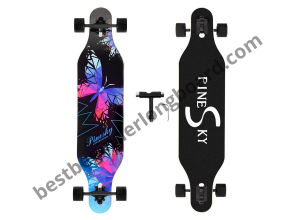Snowboarding and skiing get all the glory during the winter months, but what about longboarding? This lesser-known activity can be just as much fun, and it’s perfect for those who want a more leisurely ride down the slopes. If you’ve never tried it before, don’t worry – we’re here to help! In this article, we’ll give you some tips on how to longboard on snow and make your first time a breeze.
One of the most important things to remember when longboarding on snow is to dress appropriately. This means layers, layers, and more layers. You’ll want to start with a base layer that wicks away moisture, followed by a few insulating layers. On top of that, you’ll need a waterproof outer layer to keep you dry. And last but not least, don’t forget your gloves, hat, and scarf!
Once you’ve got your outfit sorted, it’s time to hit the slopes. When you’re first starting, it’s best to find a gentle hill to practice on. Start by standing at the top of the mountain in an athletic stance – feet shoulder-width apart, slightly bent. Then lean into your turns, and use your hands to help you balance.
Remember to keep your knees bent as you ride down the hill, and be prepared to fall – that’s part of the learning process! If you take a tumble, make sure to protect your head by tucking and rolling.
Once you’ve got the basics down, it’s time to start picking up speed. With a little bit of practice, you’ll be longboarding on snow like a pro! Just be careful not to go too fast too soon, or you might lose control.
Have you ever tried longboarding on snow? What tips would you add for beginners? Share your thoughts in the comments below!
Happy riding!
Don’t Look Down at Your Board (or knees)
It’s tempting, especially if you’re new to the sport, to focus your gaze on where you’re stepping. This is a bad idea. Snow is much more slippery than asphalt, so it’s not as easy to stay in control, and looking down at what you’re doing is just asking for trouble.
Lean Into Your Turns
Since snow tends to be more slippery, you need to bear down and lean into your turns. Limping through a turn on ice will not get you very far.
Don’t Go Too Fast (At First)
The first time you go out in the snow (especially if there has been more than one snowfall), it’s best to stay under 30mph. The first time you take the road, it’s essential to make sure you react if anything goes wrong. If you’re going too fast, then there is a good chance that even if something does go wrong, you won’t be able to stop or turn in time before hitting whatever it is that caused your problems.
Wear a Helmet
If you’ve been longboarding for any amount of time, then you know that helmets are essential. They’re equally as crucial in the snow because falls tend to be a lot more common on snow than regular asphalt. This is especially true if you plan on going faster than 30mph. Even though you aren’t wearing full out downhill gear, it’s still a good idea to wear protection for your head.
Check Your Tire Pressure Every Time You Go Riding
When the weather is colder than average, there is a good chance that your tire pressure will drop. If you don’t check it every time, you might go out for a ride and find that your wheels aren’t touching the ground anymore.
If It’s Bad Out, Stay Home
It can be challenging to know when it is or isn’t safe to go out on the road in the snow. All of this depends on what you’re comfortable with and how much experience you have on a longboard. If you’re new to it, keep in mind that the first time you hit the road may be a bad idea.
Get some wax for your trucks.
Snow is notoriously tricky to get out of your wheels, and getting wax will make it glide more easily across the snow.
These are some essential tips when it comes to longboarding in the snow. If there is only a little bit of snow on the ground, then the chances are that you can still go out and have fun. Just remember to be careful and don’t go too fast until you’re comfortable with your board.

![Best Skateboards For Beginners [Recommendations] SKATEBOARDS FOR BEGINNERS](https://bestbeginnerlongboard.com/wp-content/uploads/2024/05/SKATEBOARDS-FOR-BEGINNERS-150x150.jpg)




